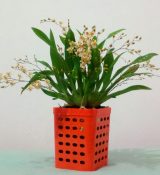Two Orchids that Don’t Have to Dress up for Halloween
Author: Celeste BoothNo Comments
Blooming, Care and Culture, Classification

Everyone knows someone that loves dressing up for Halloween. It is, afterall, a time for adults and children alike to get creative with their costume…even if it will only be worn one time.
Here are two orchids that are afforded the luxury of wearing their Halloween costumes year round without receiving judgemental stares.
Dracula Orchid
First discovered in 1870s.
Overview
This unusual looking orchid species, Dracula (latin for little dragon), gets its name thanks to the two long spurs of the sepals. There are around 120 varieties of the genus Dracula, which are native to central america and part of south america (primarily in the Andes). These orchids prefer to live in shadowy, cooler locations, and grow naturally at altitudes between 1800-2200 meters (5900-7200 ft). Closely related to Masdevallias, this genus stands out with its (often) dark colored blossoms and signature shape.
Appearance
Dracula orchids grow from a short rhizome in tufts, and do not have pseudobulbs. Compact stems each grow one large leaf, with a deeply defined midrib. The flowers often stem downward, blossoming one at a time in succession. The flower shape is generally triangular and the petals themselves are typically small and thick. Long tails extend from each sepal, and the lip is usually large and similar in appearance to that of a mushroom. In fact, the mushroom-like smell that these orchids produce attracts fruit flies, which in turn act as pollinators for the plants.
Growing Conditions
- Humidity/Watering: Draculas require high humidity (80-90 percent) as well as frequent watering. Because they are not able to store water on their own, it is important to make sure these orchids do not completely dry out. A good option is to use sphagnum moss to help keep moisture in the root system.
- Air: Good air circulation is also important, as it will help insure you avoid issues with rot.
- Temperature: Ideally, daytime temperatures should not exceed 70ºF, and should drop between 10-15 degrees overnight.
- Light: Preferably a shaded environment (somewhere between 600-1500 foot candles of light will be fine).
- Repotting: It is best to repot during the spring or fall months.
Ghost Orchid
Discovered in 1844.
Overview
The ghost orchid is aptly named, as its blossoms look as if they are floating in the air. In addition, they are extremely elusive and are now on the list of Florida’s threatened and endangered plants. In fact, because of their rarity, it is illegal to remove them from the wild. The ghost orchid has probably been made most famous by the movie Adaptation (based off the book “The Orchid Thief”), and is native to Southwestern Florida, Cuba, and other Caribbean islands.
Appearance
The ghost orchid is a leafless epiphyte, anchoring its roots in a host tree throughout its lifetime. In some instances, during the orchid’s first year, it may grow small leaves whose chlorophyll helps aid in the early growth. By the end of this first year, however, the leaves have disappeared and the root system is now the main resource of chlorophyll. It takes several years for the ghost orchid to reach maturity to bloom, but when it does, a beautiful white blossom appears, emitting an apple-like scent. The orchid may bloom for several weeks, and can have up to ten blossoms, although a single blossom is more likely. The flower itself is a little over an inch wide and around four inches long. Two long tendrils from the petals give the flower its distinct look, and since the roots blend in easily with the tree, the flower almost looks as if it’s hanging mid-air.
Growing Conditions
- Humidity/Watering: High humidity and regular watering are important, but be sure that the roots are not left sitting in water. Chlorinated water or water with high salt levels will kill the roots. Keep the roots moist for optimal growth, avoiding conditions that are too wet or dry.
- Air: Ghost orchids prefer stagnant air. Consider growing in a greenhouse or terrarium to be able to best control humidity, temperature, and air conditions.
- Temperature: Typically a hot, moist climate is this orchid’s preference. Freezing temperatures should be avoided, although to trigger blooming, one may subject the plants to cooler temperatures and lowered humidity for several months around fall/winter time.
- Light: Little direct sunlight.
Do you have experience growing Dracula or Ghost orchids? Please feel free to share with us your own experiences or questions.
Photo Credits:
Featured Image by theoberports.com
Photo Dracula Raven via dawnrogal.com
Photo Dracula Vampira courtesy of Großräschener Orchids
Photo Dracula Orchid Drawing courtesy of Orchids Wiki
Photo Ghost Orchid courtesy of Mick Fournier
References:
http://en.wikipedia.org/wiki/Dracula_(orchid), http://www.draculaspecies.com, http://orchids.wikia.com/wiki/Dracula, http://www.orchid-care-tips.com/dracula-orchid.html, http://www.ghostorchid.info, http://en.wikipedia.org/wiki/Dendrophylax_lindenii


Ask an Expert
Questions about orchids?
Our experts love a challenge!
Photo of the Week
Submit your photo to be featured on the blog!
More Photo of the Week Winners
Submit Photo











